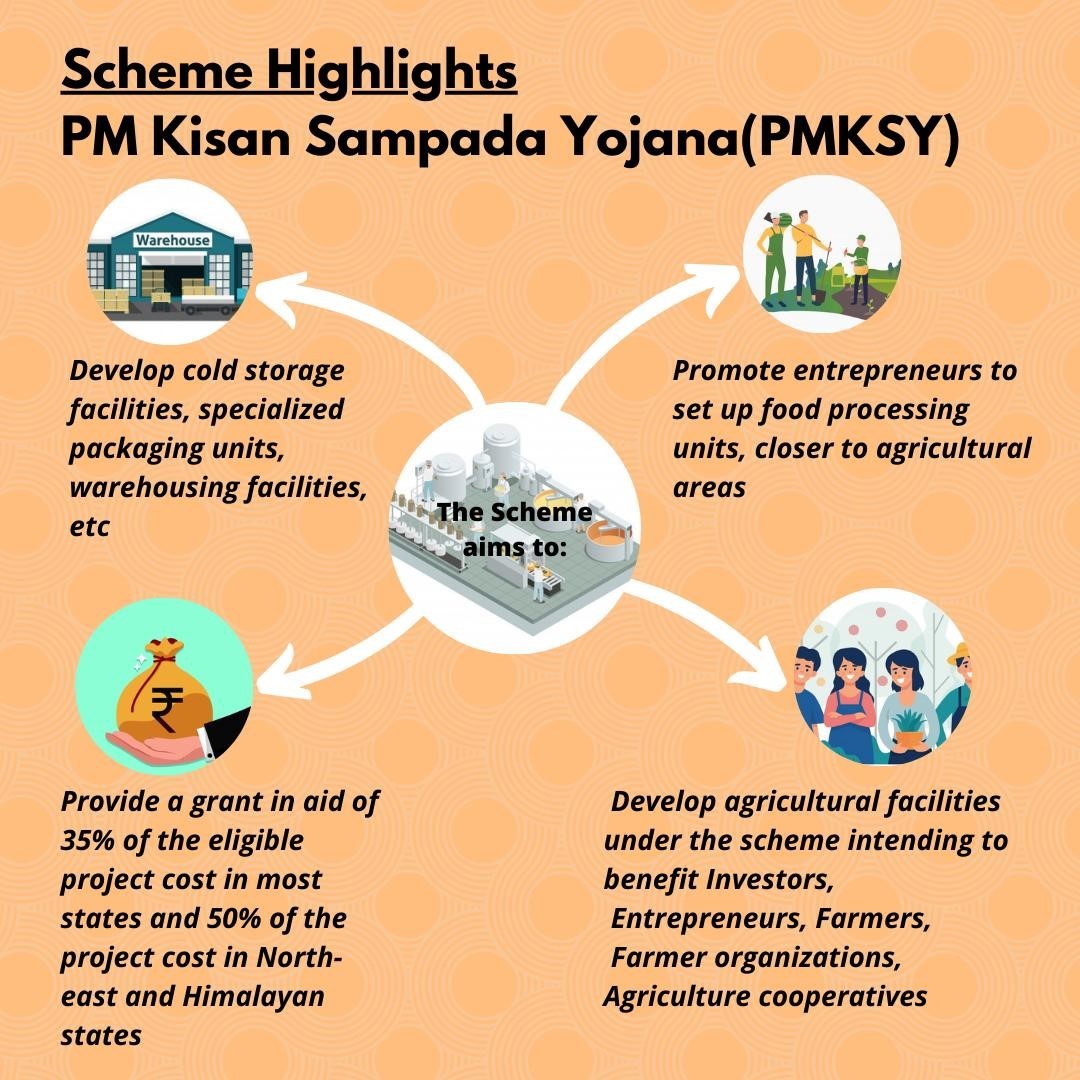Context:
The Union Cabinet, chaired by Prime Minister Narendra Modi, has approved a total outlay of ₹6,520 crore for the Pradhan Mantri Kisan Sampada Yojana (PMKSY) for the 15th Finance Commission Cycle (2021–22 to 2025–26). This includes an additional outlay of ₹1,920 crore to bolster the scheme’s ongoing initiatives.
Key Components of the New Approval:
1. ₹1,000 crore for establishing:
o 50 Multi-Product Food Irradiation Units under the Integrated Cold Chain and Value Addition Infrastructure (ICCVAI) component.
o 100 NABL-accredited Food Testing Laboratories (FTLs) under the Food Safety and Quality Assurance Infrastructure (FSQAI) component.
2. ₹920 crore for supporting additional projects across various component schemes under PMKSY.
What is Pradhan Mantri Kisan Sampada Yojana?
Pradhan Mantri Kisan Sampada Yojana (PMKSY) is a Central Sector Scheme launched in 2017 by the Ministry of Food Processing Industries (MoFPI). The main goal of the scheme is to build modern infrastructure and ensure efficient supply chain management from the farm to the retail market.
Objectives of PMKSY:
- Develop modern infrastructure for the food processing sector.
- Create an integrated supply chain starting from the farm gate to the retail outlet.
- Reduce agricultural wastage and post-harvest losses.
- Increase farmers’ income through value addition of their produce.
- Generate employment and attract investment in agri-processing.
- Improve food safety, enhance product quality, and boost global competitiveness.
PMKSY supports the entire agri-value chain and aims to make Indian agriculture more profitable and efficient.
Major Components of Pradhan Mantri Kisan Sampada Yojana:
Pradhan Mantri Kisan Sampada Yojana (PMKSY) includes several key schemes to boost food processing and reduce wastage, like:
1. Integrated Cold Chain and Value Addition Infrastructure (ICCVAI)
o Helps build cold storage, refrigerated transport, and value-addition units to reduce spoilage.
2. Creation/Expansion of Food Processing & Preservation Capacities (CEFPPC)
o Supports setting up new or expanding existing food processing units to add value to farm produce.
3. Food Safety and Quality Assurance Infrastructure (FSQAI)
o Sets up food testing laboratories to ensure food quality and safety standards are met.
4. Operation Greens
o Started with Tomato, Onion, and Potato (TOP) crops, and now includes 22 perishable crops to stabilize prices and reduce losses.
5. Mega Food Parks
o Promotes cluster-based food processing zones with modern infrastructure for businesses and farmers.
6. Backward and Forward Linkages
o Strengthens supply chain connections between farmers and food processors for better efficiency and farmer income.
7. Human Resources and Institutions
o Focuses on skill development, training, and research in the food processing sector.
How is India’s Food Processing Sector Growing?
- India’s food processing sector has seen strong growth in recent years. The Gross Value Added (GVA) of the sector increased from ₹1.34 lakh crore in 2014–15 to ₹2.08 lakh crore in 2021–22, showing significant progress.
- It has also become a key area for foreign direct investment (FDI), attracting USD 6.185 billion in FDI equity inflows between April 2014 and March 2023. This reflects growing investor confidence in the sector.
- On the trade front, the share of processed food exports in India’s total agricultural exports rose from 13.7% in 2014–15 to 25.6% in 2022–23. This sharp rise indicates better value addition and global competitiveness of Indian food products.
- The sector is also a major source of employment. It contributes to 12.22% of total jobs in the registered/organized manufacturing sector, making it an important pillar for India’s economic and job growth.
Conclusion:
The Cabinet’s ₹6,520 crore push to revitalise PMKSY during the 15th Finance Commission cycle reflects a sustained commitment to transforming India’s agricultural economy through infrastructure, technology, and food safety.







